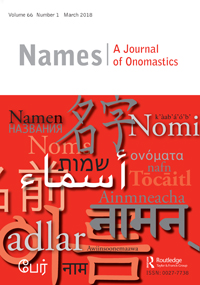Published 2018-01-02
Keywords
- veterans,
- medical facilities,
- Act of Congress,
- Veterans Health Administration,
- public laws
Copyright (c) 2018 American Name Society

This work is licensed under a Creative Commons Attribution 4.0 International License.
Abstract
It has been previously shown that participants recall a greater number of known (familiar or famous) people with the same first name as their own than do paired participants, and vice versa. For example, if Mary and Sarah were paired, Mary recalled, on average, more people called “Mary” but fewer people called “Sarah” than Sarah did. The present study evaluated further whether this own-name bias can be impacted by a strong closeness between the self and the comparison target, by examining whether the bias would still occur in pairs of twins. The results showed that twins recalled more people with the same first name as their own than did their co-twins. Thus, the present study showed that an own-name bias in memory may occur between twins. However, the size of the effect obtained in the present study was smaller than in identical experiments previously conducted with less intimate participants.
References
- Alin Åkerman, B., and E. Suurvee. 2003. “The Cognitive and Identity Development of Twins at 16 Years of Age: A Follow-up Study of 32 Twin Pairs.” Twin Research 6 (4): 328–333.10.1375/136905203322296719
- Bower, G. H., and S. G. Gilligan. 1979. “Remembering Information Related to One's Self.” Journal of Research in Personality 13 (4): 420–432.10.1016/0092-6566(79)90005-9
- Brédart, S. 2016. “A Self-reference Effect on Memory for People: We Are Particularly Good at Retrieving People Named like Us.” Frontiers in Psychology 7: article 1751.
- Cunningham, S. J. 2016. “The Function of the Self-attention Network.” Cognitive Neuroscience 7 (1-4): 21–22.10.1080/17588928.2015.1075485
- Cunningham, S. J., and D. J. Turk. 2017. “Editorial: A Review of Self-processing Biases in Cognition.” Quarterly Journal of Experimental Psychology 70 (6): 987–995.10.1080/17470218.2016.1276609
- Faul, F., E. Erdfelder, A.-G. Lang, and A. Buchner. 2007. “G*Power 3: A Flexible Statistical Power Analysis Program for the Social, Behavioral, and Biomedical Studies.” Behavior Research Methods 39 (2): 175–191.10.3758/BF03193146
- Griffin, Z. M., and T. Wangerman. 2013. “Parents Accidentally Substitute Similar Sounding Sibling Names More Often than Dissimilar Names.” PLoS ONE 8: article e84444.10.1371/journal.pone.0084444
- Holeckova, I., C. Fischer, M. H. Giard, C. Delpuech, and D. Morlet. 2006. Brain Responses to a Subject's Own Name Uttered by a Familiar Voice. Brain Research 1082 (1): 142–152.10.1016/j.brainres.2006.01.089
- Humphreys, G. W., and J. Sui. 2016. “Attentional Control and the Self: The Self-attention Network (SAN).” Cognitive Neuroscience 7 (1-4): 5–17.10.1080/17588928.2015.1044427
- Imafuku, M., Y. Hakuno, M. Uchida-Ota, J. Yamamoto, and Y. Minagawa. 2014. “‘Mom Called Me!’ Behavioral and Prefrontal Responses of Infants to Self-Names Spoken by Their Mothers.” NeuroImage 103: 476–484.10.1016/j.neuroimage.2014.08.034
- Määttä, K., H. Päiveröinen, R. Määttä, and S. Uusiautti. 2016. “How Did I Become Me? Identical Female Twins Describe the Development of Their Individuality.” Journal of Educational and Developmental Psychology 6 (2): 37–46.
- Mandel, D. R., P. W. Jusczyk, and D. B. Pisoni. 1995. “Infants’ Recognition of the Sound Pattern of Their Own Names.” Psychological Science 6 (5): 314–317.10.1111/j.1467-9280.1995.tb00517.x
- Parise, E., A. D. Friederici, and T. Striano. 2010. “‘Did You Call Me?’ 5-Month-Old Infants Own Name Guides Their Attention.” PLoS ONE 5: article e14208.
- Pietilä, S., A. Björklund, and P. Bülow. 2013. “‘We Are Not as Alike, as You Think’ Sense of Individuality within the Co-twin Relationship along the Life Course.” Journal of Aging Studies 27: 339–346.10.1016/j.jaging.2013.08.001
- Sheen, M., S. Kemp, and D. Rubin. 2001. “Twins Dispute Memory Ownership: A New False Memory Phenomenon.” Memory & Cognition 29 (6): 779–788.10.3758/BF03196407
- Sui, J., X. He, and G.W. Humphreys. 2012. “Perceptual Effects of Social Salience: Evidence of Self-prioritization Effects of Perceptual Matching.” Journal of Experimental Psychology: Human Perception and Performance 38 (5): 1105–1117.
- Symons, C. S., and B. T. Johnson. 1997. “The Self-reference Effect in Memory: A Meta-analysis.” Psychological Bulletin 121 (3): 371–394.10.1037/0033-2909.121.3.371
- Tacikowski, P., and H. H. Ehrsson. 2016. “Preferential Processing of Self-relevant Stimuli Occurs Mainly at the Perceptual and Conscious Stages of Information Processing.” Consciousness and Cognition 41: 139–149.10.1016/j.concog.2016.02.013
- Turk, D. J., S. J. Cunningham, and C. N. Macrae. 2008. “Self-memory Bias in Explicit and Incidental Encoding of Trait Adjectives.” Consciousness and Cognition 17: 1040–1045.10.1016/j.concog.2008.02.004
- Yang, H., F. Wang, N. Gu, X. Gao, and G. Zhao. 2013. “The Cognitive Advantage for One’s Own Name is Not Simply Familiarity: An Eye-tracking Study.” Psychonomic Bulletin & Review 20 (6): 1176–1180.10.3758/s13423-013-0426-z

